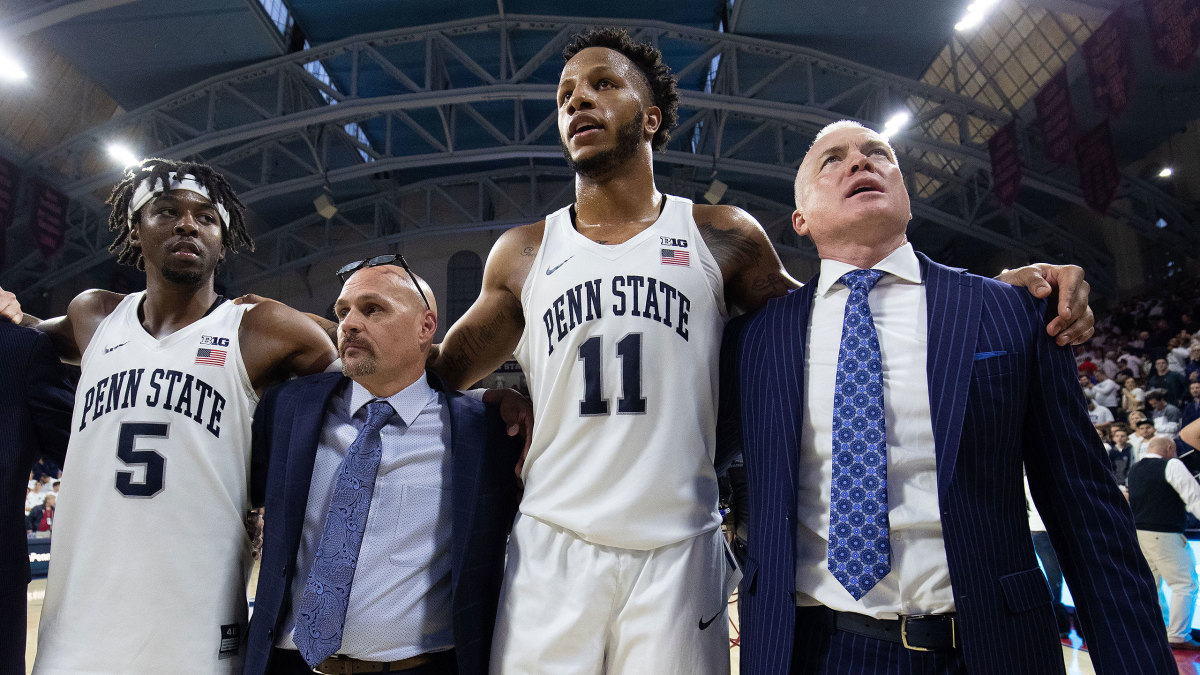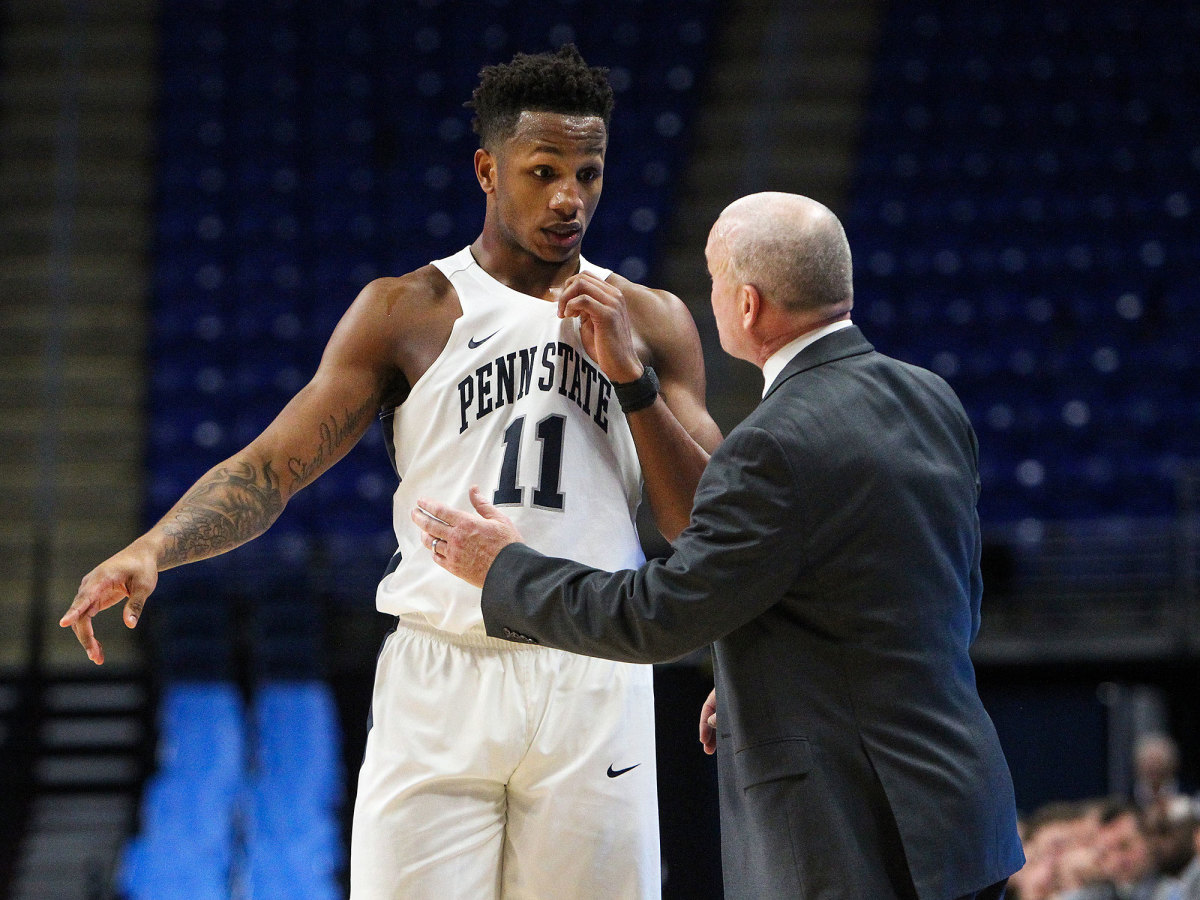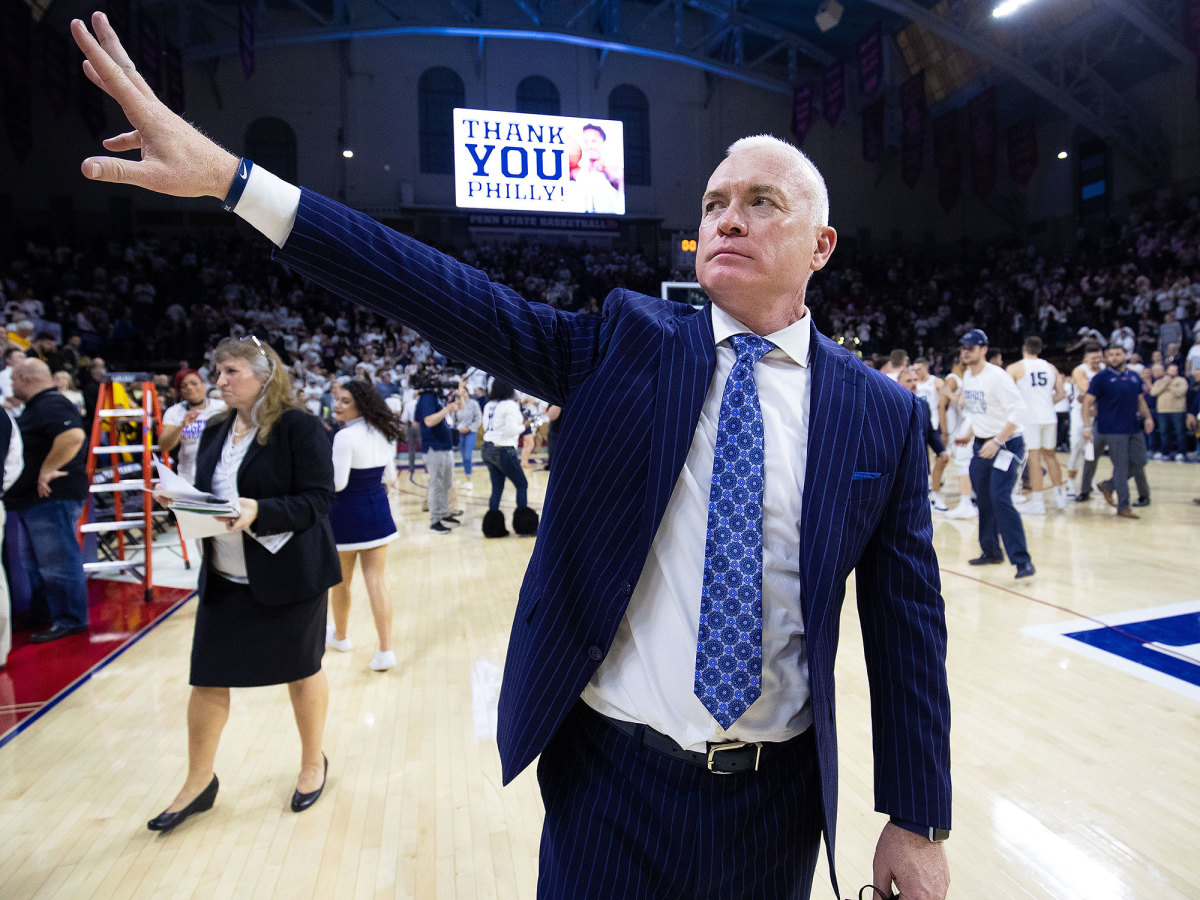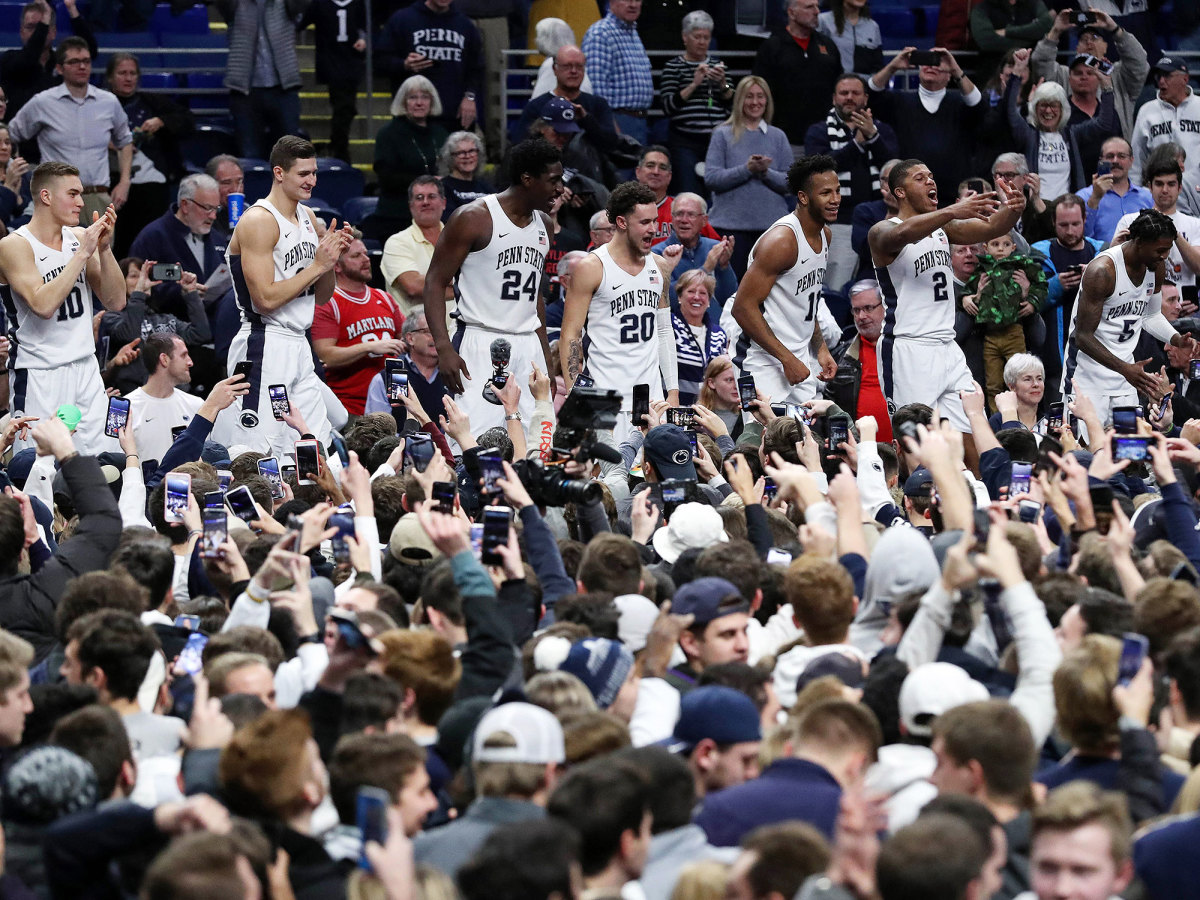Lamar Stevens, Penn State and 'The Climb' Cut Short

Patrick Chambers awoke at 5:45 a.m. Friday morning ready to work. He had a million things to go over and didn’t have the luxury to let a single moment go to waste. His Penn State basketball team was going to the NCAA tournament for the first time in his nine years in State College, the sixth time in 60 years and ninth time in program history.
He had barely wiped the sleep from his eyes when it hit him. He was preparing for something that wasn’t going to come. The NCAA had canceled the March Madness tournament Thursday afternoon while Chambers and the Nittany Lions were en route back to Pennsylvania. They had departed Indianapolis with a sliver of hope shortly after the Big Ten tournament was scrapped due to the coronavirus outbreak.
“We get on the plane and we leave, and we’re thinking Selection Show Sunday,” Chambers said in a phone interview Saturday morning. “We’re going to have a great little celebration. We’re ready to go. We can’t wait to see where we’re seeded. We’re fired up, that’s what we’re talking about.
“But inside I knew that the percentages of the NCAA tournament being either delayed—I was hopeful for a delay—or canceled were very real.”
As soon as they landed and turned on their phones they learned it was over. Chambers wanted to be the one to tell his team, to ease the inevitable gut punch that comes when an unsettling ending has no closure. Like many colleges, Penn State has shut down campus and made all classes online-only for at least a few weeks to prevent the spread of the coronavirus. The only direction the coach could give was to tell his players they had to go home.
“Right now I don’t even know what to do,” Lamar Stevens said in a phone interview. “We had planned to play right now, playing late into March.”
Stevens, a senior forward, finished his Penn State career seven points shy of becoming the program’s all-time scoring leader, a feat he almost certainly would have accomplished had the Nittany Lions played their scheduled game against Indiana Thursday night in the Big Ten tournament.
Instead, he was sitting at his home in Philadelphia on a Friday night talking to me, his dogs barking in the background and keeping him company.
“I felt like all year we knew that we were going to be in the tournament,” Stevens said. “We were too talented to not be one of the best teams in the country.”
That Penn State’s best season in Stevens’s lifetime ended as abruptly as it did, with him seven points shy of the scoring record, is almost too fitting. The story of Penn State’s emergence cannot be told without him. Chambers would be the first to admit Stevens was the biggest reason for the program’s rise.
“He was the Saquon Barkley for basketball,” Chambers said. “He’s put us on a level, on a stage that we so desired to be on.
“He will always be looked at as the greatest Penn State basketball player to ever play. Even though he’s seven points away.”
***

Chambers was hired as Penn State’s coach the year after the team’s last NCAA tournament appearance, taking over for Ed DeChellis, a Penn State alumnus who departed for Navy. DeChellis wanted an extension for leading Penn State to its first tournament appearance since 2001. Feeling unwanted, DeChellis took the Navy job for less money because it offered him security.
The Nittany Lions turned to Chambers, a Philadelphia native who had just led Boston University to an NCAA tournament appearance. Chambers played for Hall of Fame coach Herb Magee at Philadelphia University and was an assistant coach on Jay Wright’s staff at Villanova. Penn State, for all its woes as a program, was a considerable step up for a 41-year-old with just two years of experience as a college head coach.
Penn State finished last in the Big Ten his first two years there, going a combined 6-30 in conference play. The next three seasons were better—overall record, 50-50; conference record, 17-37—but far from successful. The most promising sign of improvement was Penn State finishing with an overall winning record, 18-16, in 2014-15, the fourth year under Chambers.
It was around this time that Chambers coined Penn State’s signature rallying cry. The Climb signified the program’s continuous push through the slog of basketball mediocrity. To those of us on campus at the time, The Climb was both lovable and laughable, especially at its most gimmicky. Like when Chambers took student season ticket holders on a literal climb—he led them on a hike up Mount Nittany.
These were the years when only the diehard hoops fans showed up, even though the price of season tickets was less than a 24-pack of Natty Lite. I graduated from Penn State in 2018 and covered the 2015-16 basketball team for the student newspaper. Each home game, one of the local sportswriters ran an attendance pool. He would make his way down press row and ask the media members who wanted to play to throw in a dollar and tell him their guess for that game’s paid attendance. The winner, who usually pinned the uninspiring attendance figures between 5,000-7,000 fans, would take the pot.

“I remember my first game and it was almost empty,” said Stevens, whose first home game was an 87-81 loss to Albany. The paid attendance was 6,230, less than half the Bryce Jordan Center’s 15,261 capacity.
There were moments, though, when The Climb made progress, most notably when Penn State won the NIT tournament in 2018. But each time the team hit a milestone, it inexplicably took a few steps backward. Last year, coming off the strong finish and NIT title, the Nittany Lions started 0-10 in conference play before winning seven of their last 10.
It was that strong final stretch last season that made Stevens want to stay for his senior year.
“Even through the skid that we hit, I still saw the talent,” Stevens said. “We had all the pieces coming back. I felt like I could help that.”
His return was no guarantee. The 6’8” forward earned All Big Ten Conference first-team honors and could have hired an agent and turned professional, like his former teammate Tony Carr did the year before. Without Carr, Penn State went from NIT tournament champion to 10th place in the Big Ten. The Nittany Lions likely would have had a similar season this year had Stevens not returned.
Shortly after summer workouts began in June, Stevens was already saying Penn State was a top-10 team, which was almost universally written off as preseason optimism. He saw something was different. His teammates were playing faster than they had before and they revamped their offense to take advantage of it. They emphasized forcing turnovers on defense, playing in transition on offense and shooting threes. The underclassmen were playing with more confidence and control.
At the same time, Stevens took a more active mentorship role with the younger players, Chambers said, most notably with freshman Seth Lundy, who went to the same high school as Stevens.
When asked to recall the time he first knew this Penn State team was different than those from previous seasons, Chambers singled out two moments from the summer. The first was when Stevens said he would return for his senior season. The second came in late July, when the team went on a retreat to Stone Harbor, N.J.
The beach workout/team-bonding getaway was the turning point for Penn State, Chambers said, with the highlight being the leadership seminar the coaching staff held for the players with a guest speaker.
“We had a great Navy SEAL come in,” recalled Chambers, “and he gave us a couple of different situations on how to handle things and how to stay connected and how to trust. Then, we left—the commander, myself and my staff walked out. But the players stayed in there for over an hour, maybe longer, on their own.
“Once I recognized that and heard about that, I said we’re going to do something special this year because these guys really care about each other. When you have love and care like that, you can be really good.”
***

While Penn State finished the season unranked, the team did return to the AP poll for the first time since 1996. Starting at No. 23 in mid-December, the Nittany Lions moved to 20th over the next four weeks before three straight losses in January knocked them out for two weeks.
From the end of January through President’s Day weekend, they climbed steadily and peaked at No. 9. Penn State was a top-10 team, just like Stevens predicted.
Of course, over the next month the Nittany Lions faltered again. They lost five of their final six games, including a brutal Senior Night loss to eventual conference champion Michigan State. That night, with an almost full Bryce Jordan Center—13,437 paid attendance, more than double the total at Stevens’ first home game—Penn State held a 15-point lead at halftime and led by as many as 19. The Nittany Lions went 10-for-17 from three in the first half and then missed all 13 three-point attempts in the final 20 minutes. They lost, 79-71.
Penn State followed that up with an ugly road loss to Northwestern, the second-worst team in the Big Ten. This was the best Penn State team in at least 24 years, and its last game resulted in Northwestern’s third conference win.
“We were weary physically and mentally at the end there,” Chambers said.
Still, for the first time under Chambers, Penn State finished above .500 in conference play. After a few days to rest and reset, Chambers felt his team was rejuvenated and ready for the postseason.
Thursday morning, after a sleepless night, Chambers awoke at 5:45, nervous that college basketball wouldn’t make it through the day. The NBA had suspended its season indefinitely the night before when Utah Jazz center Rudy Gobert tested positive for the coronavirus. The Big Ten tournament also had its own scare Wednesday night when Nebraska coach Fred Hoiberg had to leave in the first half of his team’s first-round loss to Indiana with an illness. Hoiberg was taken to the hospital and his team was quarantined in the locker room for almost an hour while awaiting the results of Hoiberg’s coronavirus test, which came back negative.
“When I saw it hit the NBA and they canceled their season, there was just such an empty feeling inside,” Chambers said. “We’re all pretty smart guys. You’re hopeful that they could come up with solutions and options, but you have an idea.”
To keep his players focused, he brought them to the gym for a morning shoot-around before the first game of the day, between Michigan and Rutgers, was scheduled to begin. Around 11:30 a.m. local time, he decided to go for a walk around Indianapolis to clear his head. Before he made it out of the lobby he got a text from the university's deputy AD Lynn Holleran. He knew it was over.
This time there was no loss that ended it, no glaring mistake the team could point to and say, If only we had done this better. That’s what makes the way this season ended all the more jarring.
Two days later, Chambers still didn’t know what to make of it. He was out of bed again at 5:45 a.m. in a state of disbelief. It was “Groundhog Day,” but with an unfulfilled season getting him out of bed instead of a Sonny and Cher song.
And then it hit him again, as it had Friday and as it probably did Sunday morning and today. Time didn’t stop with The Climb. All he could do was look back at this year’s team and wonder what could have been.
The NCAA announced Sunday that it would not be releasing the March Madness bracket with the seeds of the 68 teams that would have made the tournament had it been held. What good would it do?
For the Nittany Lions—along with Rutgers and Hofstra—though, that was their last chance for long-awaited official recognition. The record book will be left blank, leaving teams to fill it in themselves.
***

There is still plenty of optimism for Penn State basketball moving forward. The Nittany Lions are graduating only three regulars—Stevens, Mike Watkins and Curtis Jones. Myreon Jones, who missed six games due to illness and still earned All-Big Ten honorable mention (media selection), Myles Dread and Izaiah Brockington will have two years of eligibility left. And Stevens’s 'little brother,' Seth Lundy, will be an experienced sophomore for 2020-21.
Rising seniors Jamari Wheeler, a Big Ten All-Defensive team player, and John Harrar, perhaps the team’s most improved player this season, will take the leadership role from Stevens.
“Going from an 0-10 team [in conference play], to the No. 9 team in the country at one point in one year, they’ve learned so much,” Stevens said. “They’re ready to take that next step and continue to grow with the program.”
In addition to his place on the all-time scoring list, Stevens leaves the program as an NIT champion with 76 wins in his career, making his the winningest Penn State class since the school joined the Big Ten. His class’s 33 Big Ten conference wins are also the most for a Nittany Lions player in a four-year span.
For as much of an impact Stevens has had during his time at Penn State, his influence on the program will almost certainly be felt for at least another few years. First, through his returning teammates who are in position to make the NCAA tournament next year. But he’s also a Philadelphia kid and the face of the basketball program at the largest state university in Pennsylvania. His effect on future recruiting classes shouldn’t be overlooked.
And then just look at the spike in attendance. The Penn State community is now invested in the basketball team. The Climb has become a caravan in large part because of Stevens.
“His impact is still yet to be determined,” Chambers said of Stevens. “His legacy is still being written.”
Chambers said Penn State will include the 2019-20 season on the banner in the Bryce Jordan Center listing the program’s NCAA tournament appearances. He also said he would find a way to recognize Stevens as the all-time scoring leader, though he admitted he didn’t really know how he could do that.
“Everybody knows we were in,” Chambers said. “We were an NCAA tournament team. You can’t steal that from me and this program and Lamar Stevens. No way.
“That year is going to go up on a banner, that’s for darn sure.”
